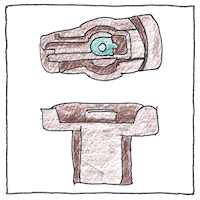Leo Baekeland
materials science

|
Bakelite
Bakelite, a combination of phenol and formaldehyde put under pressure and cured, was the first synthetic thermoset plastic—made in a variety of colors, molded or extruded— non-conductive, heat-resistant, “material of a thousand uses,” said Leo Baekeland.
Products
Airplane propellers, electric fans, distributor rotors, phonographs, radios, telephones, cameras, televisions, television antennas, television knobs, thermometers, voltmeters, vaporizers, cigarette lighters, pens, pen holders, letter openers, desk blotters, typewriters, toasters, coasters, castagnettes, base socket for light bulbs and vacuum tubes, light sockets, bed lamps, bike lamps, pipe stems, razor handles, pencil sharpeners, napkin rings, pocker chips, ash trays, dice, buttons, billiard balls, brake pads, buckles, brooches, bangles, barrettes, earrings, toys, and tiddlywinks.
Plastic
Make me, mold me.



In 1944 when Leo Baekeland died, Bakelite had been used in over fifteen-thousand products.
In 1907, Adelaide A. Pollard wrote the hymn “Have Thine own way, Lord” including the line “Mold me and make me after Thy will.”
See also in The book of science:
Readings in wikipedia:
Other readings: